The WSI Lifecycle™ is the process we use to get the best possible results for our clients. We know the Lifecycle inside and out, but it’s important that you – our clients – know it as well. Providing clients with the knowledge to understand what, how and why we’re recommending certain strategies is a big part of our success.There are many benefits to taking the time to educate clients, but here are the top three:
<p1. It will increase client buy-in
People are much more likely to agree to something if they understand it. We can tell clients how easy it would be to boost their organic search traffic by ranking for some low-hanging longtail keywords, but if they don’t understand what that means, we may as well be speaking gobbledigook. Would you pay for something without an understanding of how it helps you?
2. It makes it easier to see results
This ties in directly with #1, but by explaining to clients what we’re going to do and what is most likely to happen, they can be on the lookout for results. We might tell clients that our campaigns will increase their conversion rates, but if they don’t understand that we’re referring to them turning a higher percentage of their current websites visitors into paying customers, they aren’t going to be very impressed by our numbers.
3. It builds trust
We take the time to educate clients because it’s the right thing to do. Clients should know what and why we’re doing something so they can decide for themselves if it’s what they want. People are more likely to listen to a recommendation if they trust the person giving it.
At WSI, we’ve been honing our Lifecycle since 2002 and we think we’ve just about perfected it. The process gets results, and now we’re letting clients in on all the fun.
An Infographic For Your Troubles
Without further ado, here’s a peek at our WSI Lifecycle infographic. It was created to help outline the benefits of our Lifecycle process to clients, so they understand what goes on behind the scenes.
Are you ready!?
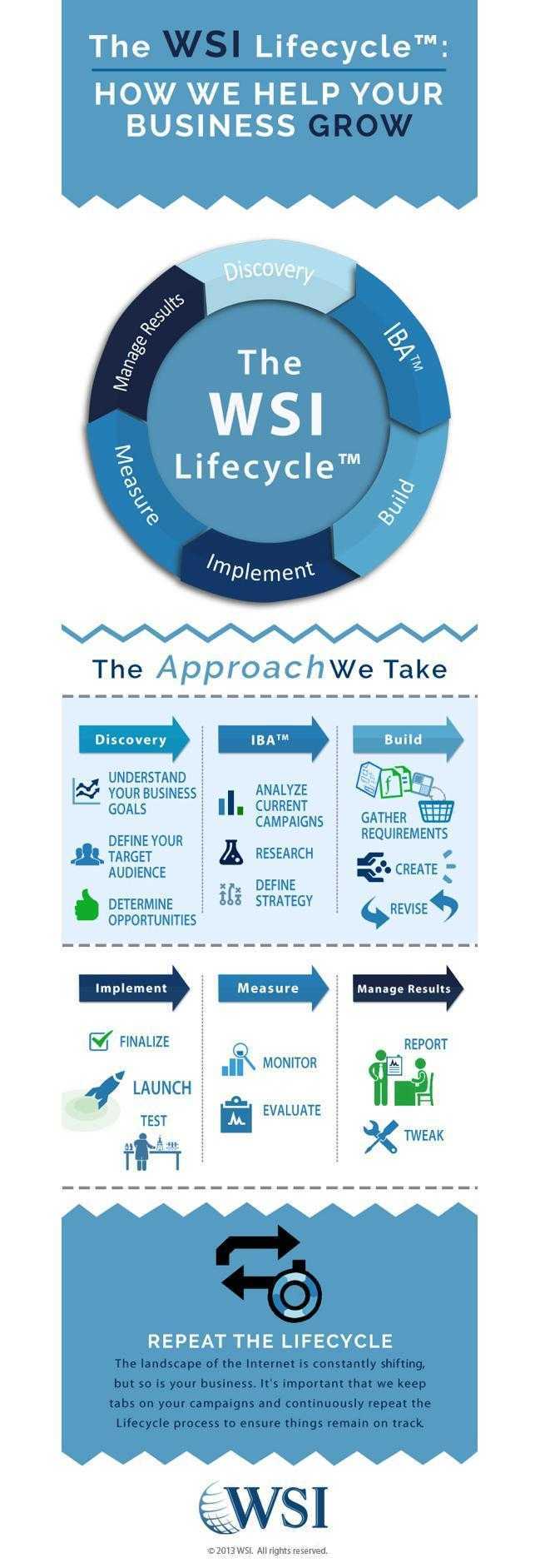
Now it’s time to break it all down and figure out exactly how our process goes to work for your business:
Discovery
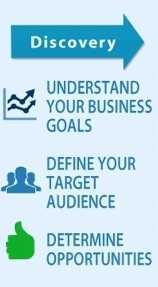 The Discovery phase is where we soak up any information we can find on your business. We’ll scour the Internet and determine what we think the business is about, then we’ll talk to you and your team to see how you actually want to be perceived.
The Discovery phase is where we soak up any information we can find on your business. We’ll scour the Internet and determine what we think the business is about, then we’ll talk to you and your team to see how you actually want to be perceived.
The main functions of the Discovery phase are:
1. Understand your business goals
In order to run any kind of successful campaigns, we first need to understand what your business wants to accomplish, and then further, what you want to accomplish with digital marketing. If we work backwards from your goals we’ll be able to develop a strategy that aims to accomplish exactly what you’re looking for.
2. Define your target audience
Even the most successful companies in the world can’t possibly target every person on the planet. But they certainly do know whom they’re targeting, and you should too. Just like your business goals, if we consider the personas you want to reach before getting started, we’ll have a better understanding of which tactics are best-suited to capture your audience.
3. Determine opportunities
Once we understand a little more about your business, we can begin to determine the digital opportunities available to you. We’ll also take into account your industry, company size, and any other relevant details that might help us find unique opportunities for your business.
Internet Business Analysis™ (IBA)
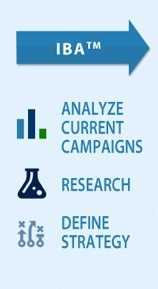 The IBA phase is where we assess the quality of your current digital presence as well as look into how you stack up against your competitors. We’ll do lots of work and research to figure out what you’re doing right and what needs to be improved.
The IBA phase is where we assess the quality of your current digital presence as well as look into how you stack up against your competitors. We’ll do lots of work and research to figure out what you’re doing right and what needs to be improved.
The main concerns of the IBA phase are to:
1. Analyze current campaigns
In some cases, you may not even be running any ‘campaigns’, but we’ll take a look at your digital efforts and try to decipher how you’re doing. This will give us a good idea of whether we need to start from scratch or work from the base you’ve already built.
2. Research
If you didn’t think you had competitors, we show them to you. They’re out there and they’re trying to steal your customers. We’ll tell you who’s out there and what (if anything) they’re doing better than you.
3. Define strategy>
Now comes the fun part. We stop looking at once was and start imaging the future of your digital presence. The strategy or planning aspect of the Lifecycle is where we’ll determine the tactics and campaigns that are going to carry your business forward into the digital world.
Build
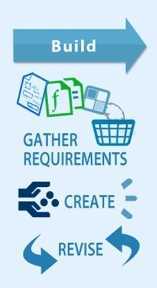 This phase probably isn’t hard to figure out – it’s where we build the components of the strategy we just devised. We’ll determine who needs to do what by when and kick the project into high-gear.
This phase probably isn’t hard to figure out – it’s where we build the components of the strategy we just devised. We’ll determine who needs to do what by when and kick the project into high-gear.
The functions of the Build phase are:
1. Gather requirements
Whether it’s design, content, or technical details, there are going to be a ton of requirements for any given digital project. And it’s during this stage that we’ll gather all of them and put them into one large basket. Just kidding. But we will try to hash out the full scope of the project.
2. Create
Ready, set, go! The project is now off and running, so here’s where we’ll get the creative juices flowing as we start to piece together all the parts of the digital marketing puzzle.
3. Revise
Just in case we didn’t get everything perfect the first time (hey, it could happen!) we’ll give you the chance to request revisions of anything we’ve built for your campaigns. We’ll ensure everything looks and reads just the way you like.
Implement
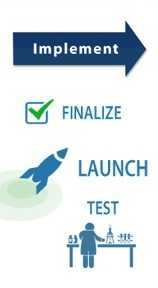 The Implement phase is where we’ll put everything we’ve built into its final place, whether it be on your site, social platform, or behind the scenes somewhere.
The Implement phase is where we’ll put everything we’ve built into its final place, whether it be on your site, social platform, or behind the scenes somewhere.
The Implement phase covers:
1. Finalize
We’ll give you one last chance to request changes and then things are set in stone forever! Not really, but we aim to produce a final version of each requirement so we can keep the ball rolling.
2. Launch
Blast off! When everything is ready to go, there’s nothing left to do but launch and hope for the best. Don’t worry, it’ll go well – it always does with us.
3. Test
Now that everything is in place, we’ll do live tests to ensure everything is working properly and looking good. Once the tests are complete, it’s time to sit back, relax, and enjoy the show!
Measure
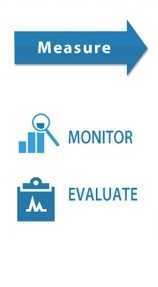 Just because everything is built and implemented doesn’t mean our job is done. Far from it. We won’t know whether what we’ve done is working until we measure and track the results, which is what we take care of during the Measure phase.
Just because everything is built and implemented doesn’t mean our job is done. Far from it. We won’t know whether what we’ve done is working until we measure and track the results, which is what we take care of during the Measure phase.
During the Measure phase we:
1. Monitor
Whether it’s conversions or organic rankings, we’ll keep an eye on the metrics that we’re trying to improve, just to get an early read on how things are working. No jumping to conclusions, just a healthy dose monitoring.
2. Evaluate
Once we have enough data – and this usually takes three months or longer – we’ll determine how successful our campaigns were at achieving the goals we set out to accomplish. There’s always some level of uncertainty as to what’s going to work best, but you can never know for sure until you try!
Manage Results
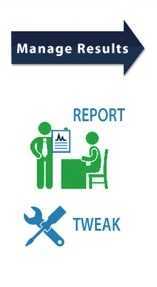 Now that the numbers are in, we’ll need to decide what the numbers are telling us to do. The Manage Results phase is all about making campaigns more efficient by removing what isn’t working and expanding on the things that are driving results.
Now that the numbers are in, we’ll need to decide what the numbers are telling us to do. The Manage Results phase is all about making campaigns more efficient by removing what isn’t working and expanding on the things that are driving results.
The main functions of the Manage Results phase are:
1. Report
Instead of having you worry about it, we’ll set a reporting date beforehand, and then we’ll come in and give you the scoop. We’ll provide our insight on what’s happening and get your input on how you’d like us to proceed with managing your campaigns.
2. Tweak
After we give you our report and get your input, we’ll get out the monkey wrench and start tweaking your campaigns. What we do will depend on the results, but it could be anything from targeting different keywords, changing the scope of content, or adjusting the design of a landing page.
And that’s it, that’s how the WSI Lifecycle™ helps your business grow. What comes next, you ask? Well, the Lifecycle comes next – it’s a cycle! You repeat the process (or most of the process) over and over, because your business is always changing and so is this place we call the Internet.





